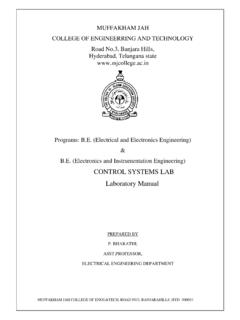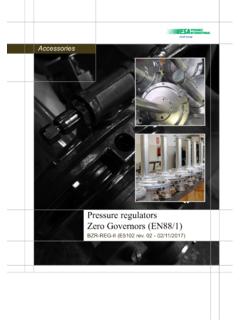Transcription of MUFFAKHAM JAH COLLEGE OF ENGINEERING …
1 MUFFAKHAM JAH COLLEGE OF ENGINEERING AND technology (Affiliated Osmania University) Banjara Hills, Hyderabad, Telangana State INFORMATION technology DEPARTMENT Network Programming Lab Manual BE III/IV II Sem . CONTENTS PAGE No. 1. 1. Institute Vision I 2. 2 Institute Mission I 3. 3 Department Vision II 4. 4 Department Mission II 5. 5 PEOs II 6. 6 POs II 7. 7 PSOs III 8. Introduction to Network Programming Laboratory VI Programs 9. Program 1:Understanding and using of commands like ifconfig, netstat, ping, arp, telnet, ftp, finger, traceroute, whois 1 10. Program 2: Socket Programming: Implementation of Connection-Oriented Service using standard ports. 5 11. Program 3 : Implementation of Connection-Less Service using standard ports 7 12. Program 4: : Implementation of Connection-Oriented Iterative Echo-Server, date and time, character generation using user-defined ports 8 13. Program 5:Implementation of Connectionless Iterative Echo-server, date and time, character generation using user-defined ports.
2 10 14. Program 6: Implementation of Connection-Oriented Concurrent Echo-server, date and time, character generation using user-defined ports 12 15. Program 7: Program for connection-oriented Iterative Service in which server reverses the string sent by the client and sends it back 14 16. Program 8: Program for connection-oriented Iterative service in which server changes the case of the strings sent by the client and sends back (Case Server). 15 17. Program 9: : Program for Connection-Oriented Iterative service in which server calculates the Net-salary of an Employee based on the following details sent by the client i)basic-sal ii) hra iii) da iv) pt v) epf ( net-sala=basic+hra+da-pt-epf). 16 18. Program 10: Program for file access using sockets. 17 19. Program 11: Program for Remote Command Execution using sockets 18 20. 19. Program 12: Implementation of DNS 19 21. 20. Program 13: Program to implement Web Server using sockets 21 22.
3 21 Program 14: Advanced Socket System Calls : Programs to demonstrate the usage of Advanced socket system calls like getsockopt( ),setsockopt( ),getpeername ( ),getsockname( ),readv( ) and writev( ). 23 Network Programming Lab Manual BE III/IV II Sem . CONTENTS PAGE No. 23 Program 15: Implementation of File access using RPC. 25 24 Program 16: Build a concurrent multithreaded file transfer server using threads 28 25 Program 17: Implementation of concurrent chat server that allows current logged in users to communicate one with other 30 26 Program 18: Demonstration of Non-Blocking I/O 31 27 Program 19: Implementation of Ping service 32 28 Annexure I : Network Programming Laboratory - OU Syllabus 34 Network Programming Lab Manual BE III/IV II Sem INFORMATION technology DEPARTMENT, MJCET I 1. Institution Vision To be part of universal human quest for development and progress by contributing high calibre, ethical and socially responsible engineers who meet the global challenge of building modern society in harmony with nature.
4 2. Institution Mission To attain excellence in imparting technical education from the undergraduate through doctorate levels by adopting coherent and judiciously coordinated curricular and co-curricular programs To foster partnership with industry and government agencies through collaborative research and consultancy To nurture and strengthen auxiliary soft skills for overall development and improved employability in a multi-cultural work space To develop scientific temper and spirit of enquiry in order to harness the latent innovative talents To develop constructive attitude in students towards the task of nation building and empower them to become future leaders To nourish the entrepreneurial instincts of the students and hone their business acumen. To involve the students and the faculty in solving local community problems through economical and sustainable solutions.
5 3. Department vision Fostering a bright technological future by enabling the students to function as leaders in software industry and serve as means of transformation to empower society through ITeS. 4. Department Mission To create an ambience of academic excellence through state of art infrastructure and learner-centric pedagogy leading to employability in multi-disciplinary fields. Network Programming Lab Manual BE III/IV II Sem INFORMATION technology DEPARTMENT, MJCET II 5. Program Educational Objectives 1. The Program Educational Objectives of Information technology Program are as follows: 2. Graduates will demonstrate technical competence and leadership in their chosen fields of employment by identifying, formulating, analyzing and creating efficient IT solutions. 3. Graduates will communicate effectively as individuals or team members and be successful in varied working environment.
6 4. Graduates will demonstrate lifelong learning through continuing education and professional development. 5. Graduates will be successful in providing viable and sustainable solutions within societal, professional, environmental and ethical context. 6. Program Outcomes PO1: ENGINEERING knowledge: Apply the knowledge of mathematics, science, ENGINEERING fundamentals, and an ENGINEERING specialization to the solution of complex ENGINEERING problems. PO2: Problem analysis: Identify, formulate, research literature, and analyze complex ENGINEERING problems reaching substantiated conclusions using first principles of mathematics, natural sciences, and ENGINEERING sciences PO3: Design/development of solutions: Design solutions for complex ENGINEERING problems and design system components or processes that meet the specified needs with appropriate consideration for the public health and safety, and the cultural, societal, and environmental considerations.
7 PO4: Conduct investigations of complex problems: Use research-based knowledge and research methods including design of experiments, analysis and interpretation of data, and synthesis of the information to provide valid conclusions. PO5: Modern tool usage: Create, select, and apply appropriate techniques, resources, and modern ENGINEERING and IT tools including prediction and modeling to complex ENGINEERING activities with an understanding of the limitations. Network Programming Lab Manual BE III/IV II Sem INFORMATION technology DEPARTMENT, MJCET III PO6: The engineer and society: Apply reasoning informed by the contextual knowledge to assess societal, health, safety, legal and cultural issues and the consequent responsibilities relevant to the professional ENGINEERING practice. PO7: Environment and sustainability: Understand the impact of the professional ENGINEERING solutions in societal and environmental contexts, and demonstrate the knowledge of, and need for sustainable development.
8 PO8: Ethics: Apply ethical principles and commit to professional ethics and responsibilities and norms of the ENGINEERING practice. PO9: Individual and team work: Function effectively as an individual, and as a member or leader in diverse teams, and in multidisciplinary settings. PO10: Communication: Communicate effectively on complex ENGINEERING activities with the ENGINEERING community and with society at large, such as, being able to comprehend and write effective reports and design documentation, make effective presentations, and give and receive clear instructions. PO11: Project management and finance: Demonstrate knowledge and understanding of the ENGINEERING and management principles and apply these to one s own work, as a member and leader in a team, to manage projects and in multidisciplinary environments. PO 12: Life-long learning: Recognize the need for, and have the preparation and ability to engage in independent and life-long learning in the broadest context of technological change.
9 7. Program Specific Outcomes PSO1: Work as Software Engineers for providing solutions to real world problems using Structured, Object Oriented Programming languages and open source software. PSO2: Function as Systems Engineer, Software Analyst and Tester for IT and ITeS. Network Programming Lab Manual BE III/IV II Sem INFORMATION technology DEPARTMENT, MJCET IV 8. INTRODUCTION TO NETWORK PROGRAMMING LAB NETWORKING BASICS Computer networking is the ENGINEERING discipline concerned with communication between computer systems or devices. It is the practice of linking computing devices together with hardware and software that supports data communications across these devices. KEY CONCEPTS AND TERMS Packet A message or data unit that is transmitted between communicating processes. Host : A computer system that is accessed by a user working at a remote location.
10 It is the remote process with which a process communicates. It may also be referred as Peer. Channel: Communication path created by establishing a connection between endpoints. Network A group of two or more computer systems linked together Server: In computer networking, a server is a computer designed to process requests and deliver data to other computers over a local network or the Internet. Iterative servers: This server knows ahead of time about how long it takes to handle each request & server process handles each request itself. Concurrent servers: The amount of work required to handle a request is unknown, so the server starts another process to handle each request. Network Programming Lab Manual BE III/IV II Sem INFORMATION technology DEPARTMENT, MJCET V Client: A Client is an application that runs on a personal computer or workstation and relies on a server to perform some operations.









